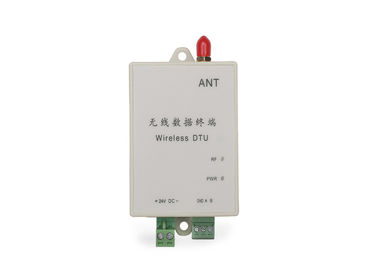RS485 Data Transmission Module 433MHz RF Data Transceiver 2km PLC Wireless Controller
General Introduction
LS-R314 wireless DTU, transmission distance reaches 3km LOS, with small size, plastic enclosure, high reliability, it is widely used for wireless communication between PLC and PC/HMI.
LS-R314 supports wireless communication between Siemens S7-200, S7-300 series PLC, Schneider PLC, Mitsubishi PLC, ABB PLC etc. It supports Modbus protocol, including Modbus ASCII and Modbus RTU protocol, PPI protocol. LS-R314 DTU can also connect with transducer, HMI or other RS485 devices. It supports point to point, point to multi-points wireless data transmission.
Wireless solution has the advantage of keep users from wiring cables in dangerous field, easy to set up, no need wire cable, shorten projects time and maintenance cost. It is a reliable and competitive solution.
Application Field
* To collect PLC/HMI for wireless data transmission
* Pressure, flow rate, temperature etc data collections, wireless transmission and control in water/waste water treatment field
* Wind speed, rainfall, humidity etc data collection, wireless transmission and control at whether monitoring station
* Temperature, humidity, concentrations of CO2 etc data collection, wireless transmission and control in agriculture greenhouse
* AGV wireless monitoring and control
Technical specification
| Frequency |
433MHz or 450MHz, 470MHz |
| Power Output |
1W (3000m LOS) |
| Protocol support |
Standard Modbus or PPI |
| Power supply |
9-36V DC usually use 24V DC or 12V DC |
| Interface |
RS-485 |
| Channel No. |
16 channels default |
| Temperature |
-35℃~+75℃ (industrial) |
| Dimension |
80×60×30(mm) exclude antenna |
Application examples



LS-R314 DTU networking
For point to mufti-points communication
If your devices don’t have ID, when one module transmits, all the others can receive the data. For example, there are A, B, C, D 4 modules.
When A send data, the modules B, C, and D all can receive.
When B send data, the modules A, C and D all can receive.
When C send data, the modules A, B and D can all receive the data.
When D send data, the modules A, B and C can all receive the data.
If you hope only the specific module can receive data. We accept polling method. Please set ID for your devices. Master will inquire slaves time by time, only the slave with specific ID can receive your data.
3) If your device really can not set ID. We can set ID for modules.
When you program serial port, please note it is half-duplex and there is wireless transmission delay.
LS-R314 DTU Notice in real application
LS-R314 DTU wireless delay time.
Wireless products have a delay time. Different RF baud rate causes different delay time. Please refer the specific delay time below:
|
RF Date Rate
(bps)
|
Delay
Ts(mS)
|
RF Date Rate
(bps)
|
Delay
Ts(mS)
|
| 1200 |
90 |
9600 |
12 |
| 2400 |
48 |
19200 |
6 |
| 4800 |
24 |
|
|
LS-R314 DTU error correction method
To promise your system stable and reliable, we suggest you add check or CRC to re-transmit data if there is error.
LS-R314 DTU’s transmission method for big data package
In theory, LS-R314 can transmit not limit data package, but we don’t suggest you to transmit too big data package. We suggest each package less than 120B, better 60-100B. Also we suggest your program use ARQ to resend the package with error.
For example, we suppose the real communication BER is 10-4, and user needs to send a 1KB file(10000bit), if you transmit via 1 package, in theory, there will be 1bit error in every receiving time, So this 1KB file can not transmit correctly all the time.
If you can divide the 1KB files into 10 package, each package transmit 100B, in theory, there might be error after you send 10 packages. Module will re-send that package via ARQ. Though, we send 1 more package and the whole efficiency reduce, but this can promise all data can be received correctly.

 Your message must be between 20-3,000 characters!
Your message must be between 20-3,000 characters! Please check your E-mail!
Please check your E-mail!  Your message must be between 20-3,000 characters!
Your message must be between 20-3,000 characters! Please check your E-mail!
Please check your E-mail! 



